Auschwitz Museum Exhibits
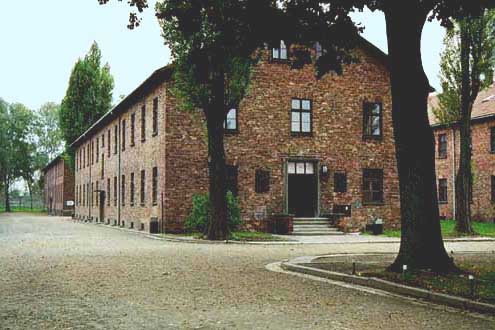 Block 15 barrack building
now houses Museum exhibits
Block 15 barrack building
now houses Museum exhibits
The visitors' tour of the main Auschwitz
camp begins in Block 15, shown in the photo above, which houses
an exhibit entitled Historical Introduction. The building is
located at the corner of the first intersection of camp streets
after you pass the camp kitchen near the "Arbeit Macht Frei"
gate, which is behind the camera on the left. Organized groups
begin their tour of the museum buildings here and then move on
to Blocks 4, 5, 6, and 7 which are in the last row of barracks
buildings.
Blocks 4, 5, 6, and 7 at the former Auschwitz
I concentration camp have been converted from barracks into museum
rooms with glass display cases. All of these exhibit buildings
are located on the second cross street, to your right after you
enter through the "Arbeit Macht Frei" gate. At the
end of this street is Block 11, the prison block which is open
to visitors.
In Block 5, there are displays devoted
to the "Material Evidence of Crime." One of the saddest
sights at Auschwitz is the display of shoes in a huge glass case
that takes up half a barracks room in Block 5. The shoes seem
to be deteriorating and are mostly the same dark gray color,
except for a few women's or children's shoes that are made of
red leather. The red shoes stand out like the red coat worn by
the little girl in Schindler's List, a black and white picture.
 Shoes in display case
in Block 5 at Auschwitz Museum
Shoes in display case
in Block 5 at Auschwitz Museum
When the Soviet Union liberated Auschwitz-Birkenau
on January 27, 1945, there were 43,000 pairs of shoes in the
camp. The photo below shows the shoes found in a warehouse.
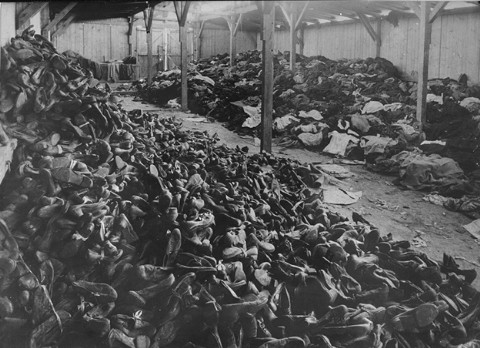
Shoes and clothing
of prisoners found at Auschwitz-Birkenau
Photo Credit: US Holocaust
Memorial Museum
The Theatergebäude
(theater building) which is located just outside the Auschwitz
main camp, was used as a clothing warehouse and it was stuffed
full when the camp was liberated. All but six of the clothing
warehouse buildings at Birkenau had been set on fire when the
camp was abandoned by the Nazis on January 18, 1945 and the buildings
were still burning when the Soviet liberators arrived on January
27, 1945.
There is a large display case in Block
5, taking up half of a barracks room, which contains the suitcases
brought by Jewish victims to the camp. The Jews were instructed
to mark their suitcases for later identification; you can still
see the names written on the leather cases in large letters in
the photo below. On some of the suitcases is the word Waisenkind,
which means orphan; this is proof that there were children among
the victims at Auschwitz.
 Display case of suitcases
used by the victims
Display case of suitcases
used by the victims
The leather suitcases have not deteriorated
like the shoes, which probably means that the shoes were disinfected
with Zyklon-B in preparation for sending them back to Germany,
but the suitcases weren't. There are also some baskets in this
display, used by the victims to carry their meager belongings
with them to the camp.
Another display case in Room 5 of Block
5, pictured below, is filled with the artificial legs and crutches
which were brought to the Auschwitz-Birkenau camps by incoming
prisoners. My tour guide in 1998 explained that the wounded Polish
war veterans from World War I accounted for most of this huge
collection.
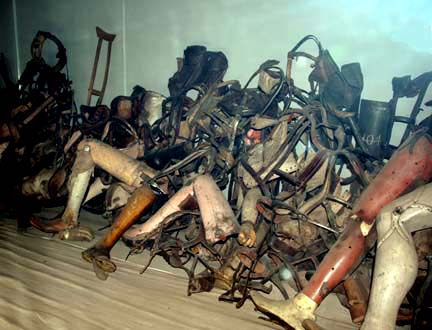 Collection of artificial
limbs worn by victims at Auschwitz I
Collection of artificial
limbs worn by victims at Auschwitz I
Block 4 has exhibits entitled "Extermination."
Holocaust historians define the German noun Ausrottung to mean
extermination. Among the exhibits in Block 4 is a model of one
of the gas chambers at Birkenau, which was used to "exterminate"
the Jews.
In a speech on October 6, 1943 at Poznan,
Poland, Reichsführer-SS Heinrich Himmler used the German verb auszurotten
and defined the word to make his meaning clear: "Ich hielt
mich nämlich nicht für berechtigt, die Männer
auszurotten - sprich also, umzubringen oder umbringen zu lassen
- und die Rächer in Gestalt der Kinder für unsere Söhne
und Enkel groß werden zu lassen. Es mußte der schwere
Entschluß gefaßt werden, dieses Volk von der Erde
verschwinden zu lassen."
Holocaust historians have translated
Himmler's words as follows: "I decided to find a clear solution
here as well. I did not consider myself justified to exterminate
the men - that is, to kill them or have them killed - and allow
the avengers of our sons and grandsons in the form of their children
to grow up. The difficult decision had to be taken to make this
people disappear from the earth."
In Room 5 of Block 4, there is a huge
glass display case, about the size of a walk-in closet, filled
with hair cut from the heads of an estimated 140,000 victims.
The hair appears to be deteriorating badly, and most of it has
turned the same shade of dark gray. This is a truly disgusting
sight and one that a visitor won't soon forget.
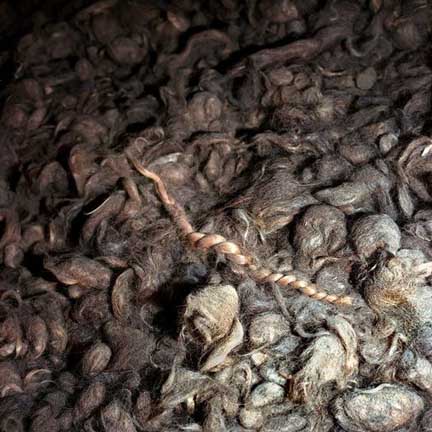 Human hair in display
case at Auschwitz
Photo Credit: Lukasz
Trzcinski
http://www.lukasztrzcinski.com
Human hair in display
case at Auschwitz
Photo Credit: Lukasz
Trzcinski
http://www.lukasztrzcinski.com
According to a Museum guide book, entitled
"Auschwitz 1940 - 1945," which was first published
in 1995, the Soviet Army found about 7,000 kilograms of human
hair, packed in paper bags, when they liberated the camp. This
was only a fraction of the hair cut from the heads of the Jews
at Auschwitz; the rest of the hair had been sent to the Alex
Zink company in Bavaria to be made into various products. Prisoners
in all the Nazi concentration camps, who were selected for work,
had all their body hair removed immediately upon arrival, in
an effort to prevent typhus, which is spread by body lice.
The following quote is from the book
"Auschwitz 1940 - 1945":
The analysis of the hair found in
the camp, made by the Institute of Forensic Medicine in Crackow,
is given below:
"Analysis of hair has shown the
presence of hydrogen cyanide, a poisonous ingredient proper to
compounds known as cyclons."
Human hair does not normally deteriorate
with age. Auschwitz survivors say that the hair in the large
glass display case was cut from the heads of the victims after
they were killed with Zyklon-B in the gas chambers. According
to Holocaust historians, this display is evidence that Jews were
gassed at Auschwitz.
The picture below shows a glass display
case in Block 4. There is a little bit of hair, including some
that is braided, and two bolts of cloth that were made from hair
combined with other material, according to my tour guide.
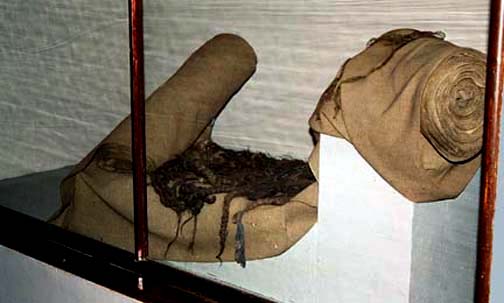 Bolt of cloth and human
hair on display at Auschwitz I
Bolt of cloth and human
hair on display at Auschwitz I
The exhibits in Block 6 are about the
"Everyday Life of the Prisoner." Included in the exhibits
are some of the enamelware dishes brought to the camps by the
victims, as well as display cases of eyeglasses, brushes and
even a display of the lids from cold cream jars and flat cans
of shoe shine wax. There is a glass case with moth-eaten baby
sweaters and another with Jewish prayer shawls which are old
and worn and have been extensively darned and patched.
One of the exhibits in Block 6 shows
the blue and gray striped uniforms worn by the prisoners. Another
display in Block 6 shows a typical day's ration of food: a chunk
of coarse whole grain bread the size of four thick slices and
a large, red enamel bowl of gray looking soup. This is real food
which was put into a glass case where it is deteriorating like
the other displays. The sickening effect of all this is overwhelming.
The infamous Auschwitz swimming pool
is located directly behind Block 6, but it was not on the tour
when I visited in 2005. The pool was for the use of the Polish
political prisoners, not for the Jews.
In Block 7 there are exhibits about the
"Living and Sanitary Conditions" in the former concentration
camp. In this building, there are three-tiered bunk beds like
the ones in the barracks at Birkenau.
Pictured below is a stove used for heating
the barracks while the camp was in operation. Several of the
display barracks have stoves just like this, which have been
left in the buildings. This is the European version of the pot-bellied
stove, except that it is rectangular and covered with ceramic
tile. The floors in the barracks are made of concrete; all of
the barracks buildings have double-paned casement windows, as
shown in the second photo below. The stairs are of granite, worn
down by the footsteps of the millions of visitors who have walked
on them over the years.
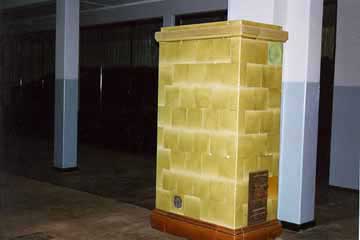 Porcelain covered stove
used to heat barracks in Auschwitz I
Porcelain covered stove
used to heat barracks in Auschwitz I
 Double-paned casement
window in barrack
Double-paned casement
window in barrack
There is an extensive display of artwork,
mostly done by survivors who created pictures based on their
memory of events in the camp. Pictured below is a drawing of
two escaped prisoners who have been captured and brought back
to the camp. They are being forced to stand beneath a sign, written
in German, which when translated into English says "Hurrah,
we're back."
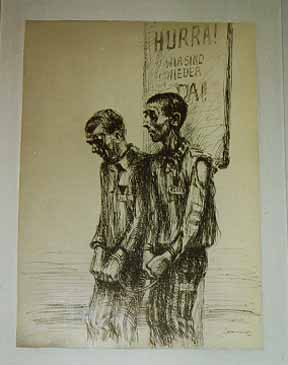 Artwork done after
the war by Auschwitz survivor
Artwork done after
the war by Auschwitz survivor
According to a book which I purchased
at the museum store, there was an art museum established at Auschwitz
I in 1941 by Commandant Rudolph Höss at the suggestion of
a Polish political prisoner. Prisoners were encouraged to create
works of art, just as at the Majdanek camp. I did not see any
of this officially sanctioned prisoner artwork on my visit to
the museum in 1998, unlike Majdanek where many drawings, woodcuts
and sculpture were prominently displayed. According to the Auschwitz
Museum web site, the kitchen building is being remodeled to display
the art work done by the prisoners.
Block 27 has special displays about the
Jewish prisoners; these displays were put up after the fall of
Communism when the plight of the Jews in the camps was given
more importance at the museum. The whole Auschwitz museum puts
heavy emphasis on the resistance movement, and in keeping with
this theme, there is a special section on the second floor which
is devoted to the Jewish resistance to the Nazis, both inside
the camp and on the outside. Jewish partisans fought with the
Polish Home Army, known as the Armia Krajowa or Polish AK, and
also organized resistance on their own.
In front of Block 27 is a small memorial
stone to the Jews who were gassed; it is the only memorial specifically
dedicated to the Jews in all of Auschwitz-Birkenau. Most of the
Jews were sent to Auschwitz II, otherwise known as Birkenau,
which had enough barracks space to house between 90,000 to 200,000
prisoners at one time. Auschwitz I was strictly a camp for prisoners
who were able to work in the factories; the old, the young and
the sick were sent to Birkenau.
Block 27 is located on the first street
that intersects the main camp street, as you enter through the
"Arbeit Macht Frei" gate. Turn to your right on this
street and go past the camp kitchen to Block 27.
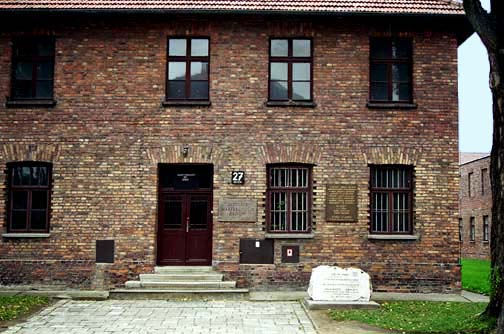 Block 27 has displays
devoted to the Jewish victims at Auschwitz-Birkenau
Block 27 has displays
devoted to the Jewish victims at Auschwitz-Birkenau
Blocks 13, 15, 16, 17, 18, 20, and 21
have exhibits devoted to the various nations that were victimized
by the Nazis.
Block 13 has a Museum devoted to the
Extermination of the European Roma, known to Americans as Gypsies.
The photo below is a display in this Museum. When I visited this
museum in September 2005, I was the only person there.
 Part of the display
in the Gypsy Museum in Block 13
Part of the display
in the Gypsy Museum in Block 13
The exhibits in Block 16 are entitled
"The Tragedy of Slovak Jews. Prisoners from the Czech Lands
at Auschwitz." Block 17 has exhibits about the prisoners
sent to Auschwitz from Yugoslavia and Austria. Elie Wiesel and his father stayed in the
barracks in Block 17 for three weeks before being sent to work
in the factories at Auschwitz III. All of the prisoners were
kept in quarantine for a few weeks to make sure they were not
suffering from any communicable diseases.
The title of the exhibit in Block 18
is "The Citizen Betrayed, to the Memory of the Hungarian
Holocaust." The Hungarian Jews were not deported until the
Spring of 1944 after the country was taken over by the German
Army.
Block 20 is in honor of the "People
Deported from France to Auschwitz (March 1942 to January 27,
1945)" and Block 21 is devoted to the "Persecution
and deportation of Jews in the Netherlands, 1940 - 1945."
Italy is also included in the exhibits in Block 21.
This page was last updated on July 29,
2009
|